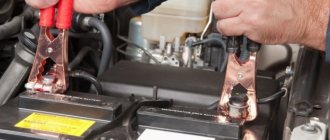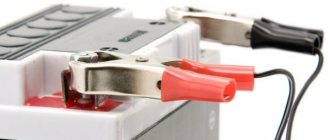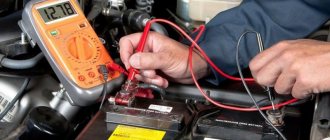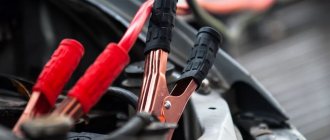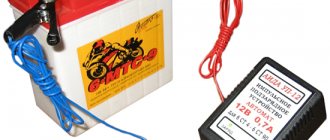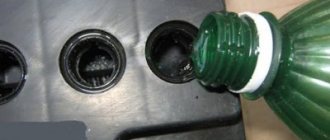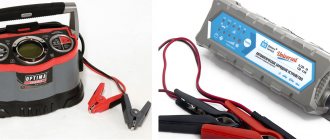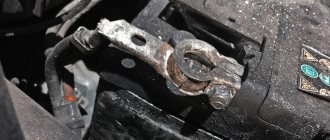Procedure for disconnecting the battery in a car
It is important to follow a certain sequence of actions when disconnecting. Otherwise, you can get into trouble in the form of short circuits, failure of elements of the electrical system, or, quite simply, the remaining ignition key inside the car with the doors locked.
So, the sequence of disconnecting the car battery.
1. Turn off all on-board network devices : stereo systems, dimensions, headlights, running lights. You should check whether the interior or trunk lighting and other electrical equipment are turned off.
2. Turn off the ignition, remove the key and be sure to take it with you. Failure to do so may result in a situation where the key becomes locked inside the vehicle. The reason is that many modern car security systems perceive disconnecting the terminals as a break-in attempt and block the doors to prevent it.
3. Remove the terminals from the battery.
Important! The following terminal removal sequence must be strictly followed. First you need to loosen the negative terminal, remove it, move it to the side and lock it in the removed position, and only then remove the positive terminal.
Do not completely unscrew the terminal fastenings. It is enough just to loosen them and, turning them left and right, carefully remove them without effort. If the terminal is oxidized, covered with a white coating and “stuck”, you should clean it with a stiff brush and use WD 40 or another similar product. After cleaning, you need to slightly twist the terminal to try to remove it. The main thing is to avoid too much force and not to try to disconnect it, no matter what. It’s better to waste time and wait for the terminal to free itself than to try to tear it out, damaging the contacts of the battery itself.
There is no need to listen to “advisers” who claim that the order of “resetting” the terminals can be anything. This is fundamentally wrong. It must be remembered that in cars the “mass” is the body. Therefore, if you disconnect the “+” first, then if you accidentally touch the car body, for example, with a wrench, a short circuit will occur with possible dire consequences - fuses and wiring may blow, contacts may burn, or worse, electrical appliances accidentally left on may fail.
If the task is to remove the battery, then you should release it from the mount and carefully pull it out. At the same time, we must remember that the battery is quite heavy, it is strictly forbidden to drop or turn it over and after removal it should only be placed horizontally.
Is it possible to remove the battery with the engine running?
And this is a truly controversial situation, dividing the army of car owners into two camps. Some believe that there is nothing dangerous in this, others believe that this act will certainly lead to serious consequences such as burnt-out equipment.
As often happens in such cases, the truth is somewhere in the middle.
That is, you can disconnect the battery while the car is running, but carefully, and only in cases where you cannot do without it. An example of such a case is a battery that is completely discharged, when there are no wires for lighting, and the only way to start the engine is to use a neighbor’s battery, which needs to be returned without turning off the engine.
So, let's look at the unpleasant moments that can happen.
Short circuit
When the engine is running, the battery is fed from the generator, that is, current flows to its positive terminal. Therefore, if it becomes necessary to remove the battery, do not allow the positive wire to touch the body or any other metal part of the engine compartment! Otherwise, a short circuit occurs, and literally in a split second the working electronics can burn out, and if you hesitate, the wiring can also burn out with the risk of ignition and a fire. Remember that the generator produces high currents, which are transmitted through the wire with the positive terminal. If it touches the body, which is connected by ground to the negative terminal of the battery, the circuit will close on itself. This phenomenon is called a short circuit.
Voltage drops
Many, even experienced motorists, are convinced that if you remove the battery while the car is running, there is a possibility that the equipment will burn out from a power surge. This is, to put it mildly, misleading. The fact is that the generator initially produces electricity, the amount of which depends on the speed of rotation of its shaft, that is, on the engine speed. And they are not constant, so generators are equipped with a voltage regulator in order to stabilize this parameter at the output. That is, no matter how fast the crankshaft rotates, the output voltage of the generator will not exceed 14.4–14.5 V. Removing the battery may well cause voltage fluctuations, but not dangerous in amplitude. If you want to play it safe, just turn on additional equipment to the maximum - air conditioning, headlights, heated windows - in this case, the voltage in the network will drop even more, down to 13.7–13.8 V, which is completely harmless for electronics.
It is worth considering one more point. The battery is not constantly charged from the generator. If it is already charged, then no current flows from the generator to it. What voltage surge can be expected in this case?
Wiring
Another myth is the statement that if you remove the battery from a running car, the wiring may burn out. The reasoning here is similar to the previous case: the relay-regulator will make sure that the voltage supplied to the battery is low, and even if the condition of the terminals is unimportant (they are dirty, oxidized), this will not lead to heating of the contact group or wiring. So none of the parts of the battery-generator subsystem should be damaged when removing the battery while the engine is running. The main thing is to monitor the positive wire and prevent it from touching the body.
The procedure for preparing the battery for winter
It's getting colder outside, winter is coming, and this means that the battery needs to be prepared for use in extreme conditions. For those drivers who avoid traveling in winter and prefer to use public transport at this time, the issue is resolved simply. It is enough just to disconnect the battery for the winter and ensure it is stored in a warm room.
In other cases, it is necessary to remove the battery and carry out a series of battery maintenance activities. These measures are mandatory to prevent unpleasant surprises, because at negative temperatures the battery capacity decreases, the load capacity drops, and cold starting with increased oil viscosity in the engine is greatly complicated.
Checking the electrolyte level. First of all, you need to clean the contacts and battery case, and then check the electrolyte level. To do this, you need to unscrew the plugs from the filler holes and make sure that the electrolyte level in each of them is between o and “maximum”. If there are no such marks, visual inspection can be carried out.
What a car owner needs to do every day
To extend battery life, a modern car enthusiast should every day:
- Carefully monitor the electrolyte level. For these purposes, a pear is used - it is used to make a fence. The electrolyte should be transparent, without sediment. If the electrolyte is low, you should add regular distilled water.
- Recharge the battery periodically, especially when the temperature is well below zero.
- Before starting the engine, “wake up” the battery - for example, flash the headlights or turn on the radio.
- Remember that you should not turn on the heating or lighting of the car immediately after the engine is started. You should give time for the electrolyte to warm up - this way the battery will be better prepared to take on the additional load.
And yes, you need to know how to remove the battery and then return it to its place, remove it from the car at night before an important trip and leave it overnight at room temperature.
When is dismantling required?
Learn more about when the battery needs to be removed:
- Recharging required. If the device is completely discharged, the driver will not start the car engine. If the battery is low, the car alarm may not work correctly. If there are malfunctions in the anti-theft system, this will cause the engine to lock. And to unlock the power unit, you may need the help of specialists.
- For storage. Many novice car enthusiasts do not use their cars in the cold season, when there is ice outside. Alternatively, you can reset the terminal from the battery, but at low subzero temperatures it will still be heavily discharged. In the garage or at home, it is easier to monitor the condition, diagnose the charge and periodically charge the device.
- Maintenance. If a car has a serviceable battery, it needs periodic diagnostics. It is necessary to check the level and density of the electrolyte solution; if it is insufficient, the consumer must add distillate to the jars. To perform these tasks, it is not necessary to remove the battery from the car, but it is better to do so for safety reasons. This way you can prevent spilling of the electrolyte solution.
- Need for replacement. If the battery is completely discharged and its service life is exhausted, the battery will need to be disconnected and removed from the vehicle. This need may arise when one or more cans are destroyed. In the latter case, the device will not be restored and will need to be replaced.
The Avtoelektrika HF channel spoke about the nuances of using and removing the battery.
Battery removal algorithm
The description of the sequence of actions constitutes the following chain of events.
Reinstallation occurs in the reverse order, that is, starting from the sixth operation and ending with the first.
If there is a decorative casing in the battery design, it must be removed by prying it off with the tip of a screwdriver.
Let's consider the process of cleaning a serviced acid battery.
Preventive actions
Battery maintenance begins with getting rid of traces of sodium carbonate. When the batteries are removed from the slots, the tightness of the plugs is checked. To neutralize the deposited electrolyte, wipe the lid with a solution of drinking (or soda ash). Then all excess is washed off with water. Use a rag to wipe the surface of the lid dry.
With the strip, plugs, plates and holes for fasteners, proceed in the same way.
The next step is to clean the vents. It should be done at least once a month. Gas outlets are built into the design of colored plugs. They are easy to find in the middle cells.
Particular attention must be paid to the design of the battery, in which the batteries are placed in a special compartment. This is the most likely place for the accumulation of dust, dirt, and deposited electrolyte. Ignoring the cleaning process, especially in hot weather, leads to evaporation of the electrolyte and causes sulfation of the plates.
If the battery is close to the exhaust manifold, it should be fenced off for the summer using a simple metal screen.
The battery removed from the compartment is checked for voltage, electrolyte level and density. How to properly charge a car battery is written in a feature article. If necessary, connect a charged device. Eliminate layers of loose oxides and traces of corrosion tracks.
Precautions when removing the battery
Before turning off the battery, familiarize yourself with the safety measures taken into account by specialists:
- With prolonged use of the battery, oxidation of the terminals may occur. To disengage the clamps, users often hit them with a hammer, pliers, or other tools. This should not be done as it may damage the terminals. Shocks and vibrations may cause destruction of the plates located inside the device, rendering the battery inoperable.
- After dismantling, throwing the battery or hitting it is not allowed. Physical damage will cause leakage of working fluid from inside the device or damage to the active component. When dismantling, you must not hit other parts of the car.
- When removing, do not place the battery on its end or turn it over. Because of this, the working fluid will leak or the plates will short out inside. The ventilation holes are clogged with an electrolyte solution. There is a separate type of battery that can be turned over, but you should not experiment.
- Do not drain the electrolyte solution from the battery cans. The working fluid contains about a third of distillate and a third of sulfuric acid. If the solution comes into contact with human skin, it will cause burns. If there is a need to drain the electrolyte, the procedure is performed in protected areas. Gloves will not protect your skin from exposure to sulfuric acid.
- It is not recommended to add acid or electrolyte solution to battery jars yourself if you do not need to increase the volume of liquid. This will cause an increase in the density parameter, which will ultimately lead to sulfation of the plates. Only distilled water can be added. If the density of the electrolyte is reduced, you need to calculate the proportions to create the acid; this is problematic to do at home.
- Do not store a removed battery in the cold at low subzero temperatures, especially if it is completely discharged. The device will freeze, in practice this will lead to the plates falling off.
If, when removing the battery, physical damage is found on the case, its further operation is not allowed.
Andrey Sopko explained the consequences of ignoring the need to disconnect the battery when carrying out welding work in a car.
Personal safety measures at work
When removing the battery, safety precautions should be followed, which include:
- Use of protective equipment during work. Since the battery is thirty-five percent sulfuric acid, it is best to use rubber gloves. When it comes into contact with the skin, this acid gradually eats away, leaving significant burns. If the leak is discovered late and contact with the skin cannot be avoided, the damaged area should be treated with soda diluted in water. It neutralizes acid and prevents severe burns.
- Careful handling of the battery. The operating instructions for the battery must be followed completely.
- Work on the battery should be done indoors with good ventilation or outdoors. Hydrogen is released from the battery vents, which in significant concentrations can cause an explosion.
Before work, you need to prepare alcohol soda or a solution of water and baking soda. If the battery is alkaline, a weak solution of any acid will help get rid of traces in time. You can use ten percent vinegar or a solution of citric acid. Any moisture-absorbing rag or rag will also come in handy.
To protect your eyes from accidental sparks from the terminals, you can use safety glasses. It is better to remove any metal jewelry - rings, chains, bracelets, as they may accidentally come into contact with battery parts and become conductors of electric current. This not only leads to a short circuit, but can also cause harm to the car owner.
ATTENTION! Proper preparation will avoid significant damage to both person and vehicle.
How to properly disconnect a car battery
The battery holds a current charge that is used for:
- Starting the engine: Without the small spark that this device provides, you will not be able to start the car.
- Using media devices with the engine off. This also applies to interior lighting, phone charging, and car radio operation.
- Generator support in cases where it cannot cope with the load. Particularly noticeable assistance is provided during long periods of idle time in traffic jams with the air conditioning, windshield wipers and rear window heaters on.
Before disconnecting the battery, you should perform a number of manipulations:
- Be sure to turn off all devices - interior lights, radio, headlights. When removing the battery with the devices turned on, a short circuit may occur.
- Turn off power to the engine. It is better to remove the keys from the ignition and put them in your pocket, as some car models automatically lock the doors when the battery is removed, which will make it difficult for the owner to get inside.
To remove the battery, you will need a wrench; as a rule, most models use 10 and 13 mm wrenches. Procedure for disconnecting the battery:
- Open the hood;
- If sound insulation or fabric protection is installed, they must be removed;
- Open the plastic protective caps from the terminals, if any;
- Unscrew the nut on the terminal with the “-“ sign;
- Remove the terminal from the battery and place it to the side;
- Unscrew the nut from the terminal with the “+” sign;
- Remove the terminal and take it to the side.
After these steps are completed, the battery is disconnected and ready for removal. The terminal with the “-” sign should be unscrewed first, since it is connected to the car body. If you first disconnect the positive terminal, the negative terminal will remain connected and, if the key accidentally touches a metal part of the car, it can cause a short circuit.
If, when removing the battery, the terminals begin to spark, this means that one of the car’s devices that consumes electric current remains turned on.
ATTENTION! Do not hit the terminals to disconnect them. If a white coating has formed on them, you should first clean them with a brush (a metal one will not work). You can use a special solvent. After treating the terminals with it, you can slightly loosen them with a screwdriver, after which it will be much easier to remove.
Features of the process of removing a car battery
The battery is turned off when the power unit is deactivated. During removal, it is necessary to take into account the equipment of the machine, namely its equipment with electronics.
Possible problems when removing the battery
Removing the battery can lead to serious problems, especially if the car is equipped with an anti-theft system or an audio system.
With alarm
If you disconnect the battery without taking into account safety measures and basic requirements, this will lead to incorrect operation of the anti-theft system:
- The electronic signaling unit can erase from memory information about communicators used to control the system. As a result, the power unit will be blocked. If the user has instructions for setting up and controlling the alarm without a pager, you can unlock the engine and rebind the remote controls.
- System functions will stop working. If the machine is equipped with auto start, this option may not function. You will need to re-configure and prepare the car for remote start.
- The system parameters will be lost.
Sometimes you can solve the problem yourself, but novice motorists will face difficulties. Malfunctions of the alarm when dismantling the battery rarely occur; this is more typical for discharged batteries.
With radio/cassette player
Removing the battery must begin by checking the audio system - make sure that the car radio has a security password for unlocking. When the battery is disconnected, the entire configured configuration will be reset, the consumer will have to re-enter the code and perform the setup.
The Avto-Blogger channel spoke in detail about the features of the procedure for dismantling a car battery.
Is it permissible to remove the battery for a long period of time?
We have already found out that in winter this is not only acceptable, but also necessary. Otherwise, you risk being left without a battery: remaining ownerless, it gradually begins to lose charge. Being discharged by 25–50%, in severe frost the battery can simply freeze (the electrolyte density decreases), which threatens to rupture the battery case.
So it is necessary to remove the battery of a car for a long time, be it a foreign car or a product of the domestic automobile industry. There is always a place for storage - on the balcony/loggia, in the pantry, closet, even on the mezzanine, as long as the temperature is above zero. In this case, you should periodically, at least once a month (preferably more often), check the voltage at the terminals, and if it drops significantly below normal, recharge the battery.
A week of machine downtime is already a controversial issue. Many experts argue that such a break does not require dismantling the battery, even if it is frosty outside - it is enough to reset one of the terminals (according to the rules - negative). Whether this is true or not is up to you to decide. It is quite obvious that seven days of downtime is really a short period of time for the warm season, but in winter, especially in the northern regions, it is still advisable to keep the battery warm.
But here the second question arises - is it possible to remove the battery from the car often? The fact is that when performing such an operation, the contact group is the first to suffer - the terminal terminals and the terminals themselves. In cold weather, the metal becomes less durable, and given that the contacts are made of soft metals, they can become deformed and even crack. So it’s still not worth removing the battery without the need to do so. Note that the terminals can be replaced, but with the battery pins it is more difficult - if they become loose or crack, repairs will be problematic.
There is another controversial point that needs to be discussed. There is an opinion, and it is supported by numerous publications on the network, that if you disconnect the battery, all car settings will be lost, and that you will even have to reflash the on-board computer.
It is not true. Important settings and basic information are recorded in the non-volatile memory of the ECU and are not reset if the power is lost! Even data such as mileage will not be reset when the battery terminals are disconnected. It would be too easy. To, for example, reset the mileage, you will have to try hard by manipulating the dashboard buttons. Moreover, you should not be afraid if you have an old-style car with almost no electronics - these are also found among foreign cars.
It is likely that the radio settings will still be reset (mostly time and date), but this is not critical data, and it is not so difficult to restore it. And modern models, all kinds of multimedia centers, are also equipped with their own non-volatile memory.
It is likely that the automatic transmission adaptation settings, if any, may be reset to zero, but you didn’t set them up - they will be restored after driving literally 50-100 kilometers, which will be enough to remember your driving style. Note that not all automatic transmissions have this functionality, but only so-called adaptive transmissions.
All of the above does not apply to some luxury car models, expensive and literally crammed with electronics (typical representatives are the Lexus and Infinity brands). Here, the battery removal procedure itself is very tricky, and manufacturers do not recommend leaving the on-board network without a battery for a long time. This is due to the fact that in addition to the ECU, such copies may also contain other control units. Although they are also non-volatile, like the main on-board computer, their batteries are much weaker, which can run out if the battery is left for a long time, which will lead to a reset. Please note that we are talking about a period of about 2–6 months. If the car is old, then this period will be a little shorter (it’s like your own battery on a computer, which can last up to 10 years).
But in this case we are not talking about critical malfunctions. Well, the seat adjustment settings will be reset, this is unpleasant, but not fatal. And with a 98–99% probability we can say that you are not the owner of such a cool car, so you definitely shouldn’t be afraid to remove the battery for a long time. In any case, the user instructions always describe such restrictions.
DIY battery removal instructions
Removing the battery yourself is a simple procedure, but when performing it, you must take into account all the nuances.
Preparing to remove the battery
If the technical documentation for the car indicates the nuances of turning off the power to the on-board network, you should definitely familiarize yourself with them.
Before removing the battery from the car, you need to properly prepare the car:
- Turn off the ignition by setting the key to Off mode. Remove it from the hole.
- Turn off running electrical equipment. This refers to optical devices, interior lighting, car radios and other devices that operate when the ignition is turned off. This is done to disable the electronics that are tied to activating the ignition.
- Close all windows and doors in the car, as well as the tailgate. If the battery is in the luggage compartment, the hood closes.
- If the car has a mass switch, then it must be turned off.
Before disconnecting the battery, we recommend that you understand the features of the anti-theft system. Some alarms automatically lock the door locks when the battery is deactivated. Therefore, the key must be in the hands of the car owner.
The Avto-Blogger channel talked about the features of preparing the battery for long-term parking and the nuances of disconnecting it from the car’s electrical network.
Disconnecting terminals - which one to start with?
First, the negative battery terminal is disconnected. There are marks on the battery case indicating the positive and negative outputs, so there should be no problems with disconnection. If there are no marks, then you can determine the positive and negative contacts by the colors of the cables connected to the terminals.
The positive contact is always red, and the negative contact is always black. This requirement is relevant for any type of car, regardless of how much electronics is installed in it.
Some consumers claim that the order in which the terminals are disconnected does not matter, but this is not true. The negative output is always connected to the machine body; this is “ground”. When the clamp is removed, the battery is disconnected from the body. If the positive contact is disconnected first and the car owner accidentally touches the body with a tool, a short circuit will occur. A power surge will damage electronic equipment, including the ECU.
A breakdown of the control unit or anti-theft installation will cause expensive repairs. These are two main systems that never turn off, even when the battery is deactivated, they are always supplied with voltage. When the negative contact is disconnected first, the “minus-body” electrical circuit will not break; this is not fraught with bad consequences for electrical equipment. If the contact of the positive output with the body is prolonged, the battery will catch fire.
Battery removal procedure
Before direct removal, you need to find out how the battery is secured. Metal brackets, ties or iron plates are used for fastening; this prevents the possibility of free movement of the device in the engine compartment. Nuts are usually used to secure the fastener. On modern car models, the battery can be installed under the driver's seat; to do this, the seat will have to be removed.
- If the ignition and electrical equipment are turned off, the engine compartment of the car opens. The device may have fabric protection or noise insulation, all of which can be removed.
- Wrenches are used to release the clamps. Most devices use 8 and 10 nuts for fixation.
- The negative clamp is disconnected. The terminal nut is loosened, the element is disconnected and moved to the side. With prolonged use of the battery, the terminal may become stuck, which will be indicated by a white coating on it. To disconnect, clean with a stiff brush, having previously treated the clamp with WD-40. You can pry the element with a screwdriver and carefully rock it in different directions; wait at least 5 minutes until the solvent begins to act.
- The positive terminal is disconnected; you will need a 10 key.
- The clamps that secure the battery are removed. The type of fastening is different.
- The battery is carefully removed from the landing site.
Caring for a removed battery
Features of servicing a dismantled battery:
- After removal, the device body is cleaned of dirt and traces of liquid. The quality of screwing the lids on jars is diagnosed. To remove remaining electrolyte, wipe the lid with a solution of water and soda. Soda ash or baking soda is used, the remaining solution is removed with plain water. The body is wiped dry with a dry cloth; similar actions are performed with the plates or strips used for fixation.
- The ventilation holes are cleaned; this procedure must be performed once a month on a removed battery. The gas outlets themselves are installed in the design of the plugs; they can be seen on medium-sized cans.
- If the plates inside the structure are located in technological compartments, these places are often clogged with dirt and residues of the electrolyte solution. It is not allowed to ignore the cleaning procedure in summer, since the working solution evaporates and this leads to sulfation of the plates.
- A procedure for diagnosing voltage, fluid level and density is performed on the dismantled battery. If necessary, the volume of electrolyte is increased.
- If the battery is low, it will need to be recharged.
How to reinstall the battery
Reinstalling the battery is as follows:
- The battery is carefully installed in its place;
- Secure with a plate or strip;
- The terminal with the “+” sign is installed in place and fixed;
- The terminal with the “-” sign is installed in place and fixed;
- The protective caps are closed;
- Sound insulation or fabric protection is installed in place;
- The hood closes.
After this, you should start the engine to make sure that the installed battery is working and that all actions performed are correct.
As a rule, removing and installing the battery is difficult only the first time. It is important to handle this part with extreme care, and also not to neglect personal protective equipment in order to protect yourself from the consequences of exposure to electrolyte.
Video “Features of preventive maintenance”
User Battery Worker reported on the main nuances of preventive maintenance of machine batteries.
When the car is parked for a long time in a parking lot or garage, when the owner goes on vacation or a long business trip, the battery discharge is inevitable. How quickly this happens depends on its wear and tear. In addition, used cars with old wiring run the risk of short circuits and even fires. To avoid such situations, if the car is left unattended for a long time, it is worth removing the terminal from the battery.
What determines the operating time on one charge?
All other things being equal, the more applications are open on a smartphone, the more the processor and electronic memory are loaded, which means that much more battery energy is consumed. Other things being equal should be understood as your usual procedure for using a smartphone. In addition to open applications, there are many others running in shadow mode, which also force the processor and memory to additionally process their information and data. Such programs include: WhatsApp, Telegram, YouTube, Mail, Yandex, Yandex Navigator, etc. You can see all of them through “Application Manager” - “Loaded”.
The operating time on one battery charge depends on the number of applications open and in shadow mode. A case in point is the use of smartphones by children. They rarely turn off applications, they simply switch to another. They may have several games open at once, videos on YouTube, additional applications: CMC, WhatsApp, contact list, etc. The smartphone is discharged in 2-3 hours, and it has to be charged; most often, children keep it on charge all the time.
If you use your smartphone only as a phone, you have to charge it once every 3 days.
How to prevent battery drain when parked for long periods of time
The battery is an important link in the vehicle network. When the driver turns off the ignition by removing the key from the lock, there are devices that continue to receive power - absorbing microcurrents. In 5-7 days, especially in the case of a new car, this will not drain the battery. But if the car sits idle for longer, the charge level may drop to a critical level of 12 V, when recharging is indispensable.
The following “consumers” are distinguished:
- alarm and beacons;
- radio;
- on-board computer;
- electronic control unit (ECU).
When a car is opened only with the alarm key fob, a completely discharged battery can cause serious difficulties: you may even need to break the glass to get into the cabin.
To preserve the battery charge, remove the terminal. But first you need to determine which one to turn off. The battery has two contacts - minus and plus. The latter is connected to the starter, power supply and other “necessary consumers”. And the negative terminal is “powered to ground”. The body, being a metal box, conducts current, and is the minus of the car. This particular terminal is removed due to the large inertial mass.
Caring for a removed battery
If the battery is removed for charging, you should simply take it to a warm place and connect it to a power source. In this case, you can perform preventative cleaning, which includes:
- Cleaning all surfaces of sodium carbonate;
- Checking the tightness of the plugs;
- Neutralize the deposited electrolyte on the lid with baking soda;
- Cleaning ventilation holes.
In this way, not only the battery itself is cleaned, but also the strips, plugs, plates and holes intended for fastening. Before returning the battery to its place, wipe all treated surfaces dry with a rag or any suitable cloth.
Is it necessary to remove the terminal?
Owners of new expensive premium cars answer negatively. Moreover, sometimes in such machines the firmware “flies” during such manipulations. To properly disconnect the terminal, the vehicle owner should read the work instructions in the service book. However, there are conditions under which it is impossible to do without tilting the terminal.
Situations when it is necessary
If the car is not in the best condition: it has a high mileage and is more than 10 years old. The driver noticed the blinking of light bulbs; when examining the interior and under the hood, sloppily laid wires and areas covered with electrical tape were visible. If the device is idle for more than 5 days, there is a possibility of a short circuit and even a fire, albeit small. To completely eliminate it, you should disconnect the terminal.
The vehicle is not planned to be used for a long time, and it has systems that operate uninterruptedly from the battery. For example, it could be a radio with a display that shows the time. The best way to preserve battery charge is to disconnect the terminal. However, the place where the car is parked must be safe, as the car will become vulnerable to thieves: the alarm will stop working.
Leaving the car for only one night, it is not advisable to carry out such manipulations. However, if the battery is prone to rapid discharge, so that it starts up without problems in the morning, the terminal can also be removed.
Why is the terminal not removed?
In addition to the short-term downtime of the car, there are a number of nuances due to which drivers do not carry out such manipulations with the battery.
- Lack of knowledge and experience - new car owners who have never done this simply do not know how to remove it correctly.
- Central locking - the driver's door is closed with a key, and all the others are practically open. The solution is simple: in manual mode, lock all the levers on the passenger doors from the inside, and then close them on the driver’s side.
- Problems with settings - some car owners believe in the myth that disconnecting the ECU from the battery can lead to the disappearance of mileage information and the car’s parameters will be lost.
- Possibility of theft - however, you can be left without a car even if the alarm is on. The main thing is to leave your car in parking lots with video surveillance or in your own secure garage.
- New battery - if the battery uses more lead, stronger plates, the charge lasts longer. However, if the car is left motionless for more than three months, it still will not survive.
When the car is parked for a long time without moving, in order to protect the battery from being completely discharged, it is worth removing the terminal. However, before doing this, you should make sure that the parking space is safe, since the car will be unprotected by the alarm.
How to “light” a car with a dead battery
Let’s briefly consider “lighting up” from another car. To do this, we drive the second car, turn off the ignition on both cars, then take the high-voltage wires and connect them from the “donor” battery to the battery of your car. It is important to connect plus to plus, and minus to minus.
After connecting the wires, the driver of the “donor” car starts the internal combustion engine and keeps the engine speed at 1500-1700 rpm. When connecting or disconnecting the cigarette lighter wires, the most important thing is to avoid contact between the positive and negative terminals, or contact of the positive terminal with the car body. Otherwise, a short circuit will occur with all the ensuing consequences (burnt wiring, problems with electrical equipment, or even a fire).
How often to charge your car battery
The frequency of charging the battery is determined individually. The battery consists of 6 sections-cans that contain the electrolyte reagent and electrodes. The most common type of car battery is WET. It uses acid as a reagent and lead as a material for electrodes.
During operation, the battery capacity decreases due to several factors:
- contamination and reduction in reagent quality;
- acid evaporation;
- sulfation of lead electrode plates.
Reducing the battery capacity increases the required charging frequency, but shortens its duration. When using the battery for a long time, it is recommended to regularly check the voltage of the device.
The normal battery charge value in the warm season is >50% of the nominal value, and in the cold season – >75%. This is due to the difference in electrolyte density, the load on the battery and the degree of risk of it turning off at different temperatures.
Motorists and service center technicians recommend charging the battery to 100% at least 2 times a year, one of which is immediately before the onset of cold weather.
